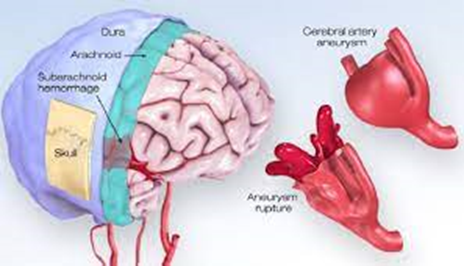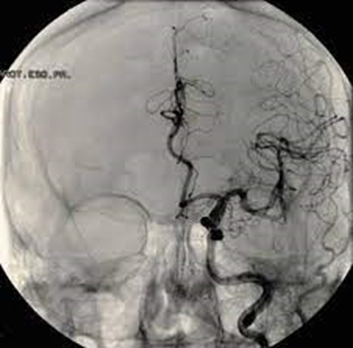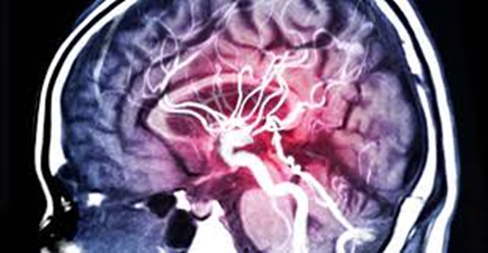Brain
Aneurysm
The Dangers of Brain Aneurysm
Aneurysms can lurk without
symptoms, but screening can save lives.
Overview
Click here for an
infographic to learn more
A brain aneurysm
(AN-yoo-riz-um) is a bulge or ballooning in a blood vessel in the brain. An
aneurysm often looks like a berry hanging on a stem.
A brain aneurysm can leak or
rupture, causing bleeding into the brain (hemorrhagic stroke). Most often, a
ruptured brain aneurysm occurs in the space between the brain and the thin
tissues covering the brain. This type of hemorrhagic stroke is called a
subarachnoid hemorrhage.
A ruptured aneurysm quickly
becomes life-threatening and requires prompt medical treatment.
Most brain aneurysms,
however, don't rupture, create health problems or cause symptoms. Such
aneurysms are often detected during tests for other conditions.
Treatment for an unruptured
brain aneurysm may be appropriate in some cases and may prevent a rupture in
the future. Talk with your health care provider to ensure you understand the
best options for your specific nee
A sudden, severe headache is
the key symptom of a ruptured aneurysm. This headache is often described as the
"worst headache" ever experienced.
In addition to a severe
headache, common signs and symptoms of a ruptured aneurysm include:
Nausea and vomiting
Stiff neck
Blurred or double vision
Sensitivity to light
Seizure
A drooping eyelid
Loss of consciousness
Confusion
'Leaking' aneurysm
In some cases, an aneurysm
may leak a slight amount of blood. This leaking may cause only a sudden,
extremely severe headache.
A more severe rupture often
follows leaking.
Unruptured aneurysm
An unruptured brain aneurysm
may produce no symptoms, particularly if it's small. However, a larger
unruptured aneurysm may press on brain tissues and nerves, possibly causing:
Pain above and behind one
eye
A dilated pupil
A change in vision or double
vision
Numbness of one side of the
face
When to see a doctor
Seek immediate medical
attention if you develop a:
Sudden, extremely severe
headache
If you're with someone who
complains of a sudden, severe headache or who loses consciousness or has a
seizure, call 911 or your local emergency number.
Brain aneurysms develop as a
result of thinning artery walls. Aneurysms often form at forks or branches in
arteries because those areas of the vessels are weaker.
Although aneurysms can
appear anywhere in the brain, they are most common in arteries at the base of
the brain.
Causes
The causes of most brain
aneurysm are unknown, but a range of factors may increase your risk.
Risk factors
A number of factors can
contribute to weakness in an artery wall and increase the risk of a brain
aneurysm or aneurysm rupture. Brain aneurysms are more common in adults than in
children. They're also more common in women than in men.
Some of these risk factors
develop over time, while others are present at birth.
Risk factors that develop
over time
These include:
Older age
Cigarette smoking
High blood pressure
Drug abuse, particularly the
use of cocaine
Heavy alcohol consumption
Some types of aneurysms may
occur after a head injury or from certain blood infections.
Risk factors present at
birth
Some conditions that are
present at birth can be associated with an elevated risk of developing a brain
aneurysm. These include:
Inherited connective tissue
disorders, such as Ehlers-Danlos syndrome, that weaken blood vessels
Polycystic kidney disease,
an inherited disorder that results in fluid-filled sacs in the kidneys and
usually increases blood pressure
Narrow aorta (coarctation of
the aorta), the large blood vessel that delivers oxygen-rich blood from the
heart to the body
Brain arteriovenous
malformation (AVM), in which the arteries and veins in the brain are tangled,
interrupting blood flow
Family history of brain
aneurysm, particularly a first-degree relative, such as a parent, brother,
sister or child
Complications
When a brain aneurysm
ruptures, the bleeding usually lasts only a few seconds. However, the blood can
cause direct damage to surrounding cells, and the bleeding can damage or kill
other cells. It also increases pressure inside the skull.
If the pressure becomes too
high, it may disrupt the blood and oxygen supply to the brain and loss of
consciousness or even death may occur.
Complications that can
develop after the rupture of an aneurysm include:
Re-bleeding. An
aneurysm that has ruptured or leaked is at risk of bleeding again. Re-bleeding
can cause further damage to brain cells.
Narrowed blood vessels in
the brain. After a brain aneurysm ruptures, blood vessels in the brain may
contract and narrow (vasospasm). This condition can cause an ischemic stroke,
in which there's limited blood flow to brain cells, causing additional cell
damage and loss.
A buildup of fluid within
the brain (hydrocephalus). Most often, a ruptured brain aneurysm occurs in the
space between the brain and the thin tissues covering the brain. The blood can
block the movement of fluid that surrounds the brain and spinal cord. As a
result, an excess of fluid puts pressure on the brain and can damage tissues.
Change in sodium level.
Bleeding in the brain can disrupt the balance of sodium in the blood. This may
occur from damage to the hypothalamus, an area near the base of the brain. A
drop in blood sodium levels can lead to swelling of brain cells and permanent
damage.
Jan Ricks Jennings, MHA, LFACHE
Senior Consultant
Senior Management
Resources
724.733.0509 Office
412,913.9536 Cell
Jan.,Jennings@EagleTalons.net
September 1, 2022




No comments:
Post a Comment